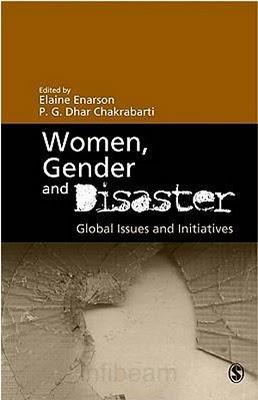Women, Gender and Disaster: Global Issues and Initiatives

Women, Gender and Disaster provides a comprehensive overview of the role gender plays in various disaster situations. Case studies and essays are divided into four parts—Understanding Gender Relations in Disaster, Gendered Challenges and Responses in Disasters, Women's Organised Initiatives, and Gender-Sensitive Disaster Risk Reduction—to further develop the myriad of issues within gender and disaster. Women, Gender and Disaster brings together cross-cultural and grassroots perspectives on both response and reduction, examining what is being done now and what could be done in the future.
While the 380 page book does not keep the reader at the edge of her seat wondering what will happen next, it does provide several concrete examples and contexts that illustrate the importance of maintaining an awareness of gender in preparing for, during, and after disaster situations. The book gives important case studies and examples for those working in the disaster management field, policy makers, academics, and students alike.
In a forward by Salvano Briceno, the Director of the United Nations International Strategy for Disaster Reduction, he discusses the expected rise in disasters in the coming years. Briceno also highlights the fact that women and men are affected differently by disasters, and suggests that Women, Gender and Disaster be used as a movement. While it is difficult to make a movement out of stagnant words, the stories, themes, and lessons learned from the case studies prove to be intertwined and interdependent, prompting even myself, a mere novice when it comes to disaster-risk management, to learn more.
Beginning with a foundational analysis, part one looks at gender and how it is differentiated from sex and sexuality. In addition, gender is examined with relation to sustainable development, and a history of conferences and workshops is provided to give the reader a greater understanding of the context. Part two looks at specific challenges, drawing from various case studies including, but not limited to: Hurricane Mitch in Nicaragua, floods in New Zealand, and Hurricane Katrina in the US. Part three focuses on specific initiatives by women’s groups. One author looks at peer learning in the aftermath of earthquakes in both Turkey and India. A case study of India’s Self Employed Women’s Association is also used to show the evolution of women responding to disasters. Part four takes a closer look at theoretical and operational concerns by examining three case studies and providing two action plans for mainstreaming gender in disaster risk management.
While Women, Gender and Disaster explicitly discusses women and gender, there is still more to be explored. A comprehensive study of power dynamics within disaster, going beyond the gendered dichotomy of male and female, and taking into account socioeconomic status, race, caste, and other overlapping systems of domination could greatly contribute to examining disaster with a truly feminist lens.
Hello-- I am viewing attempts to "gender" hot topics with increasing suspicion. Women too often are used as a way to move agendas. Check out what is hiding behind the petticoats. Disasters, natural and human-made, are sufficiently detrimental that humans of all sexes and genders need to respond without being persuaded by the self-interest of gender or used as instruments of a power grab. Frances Chapman